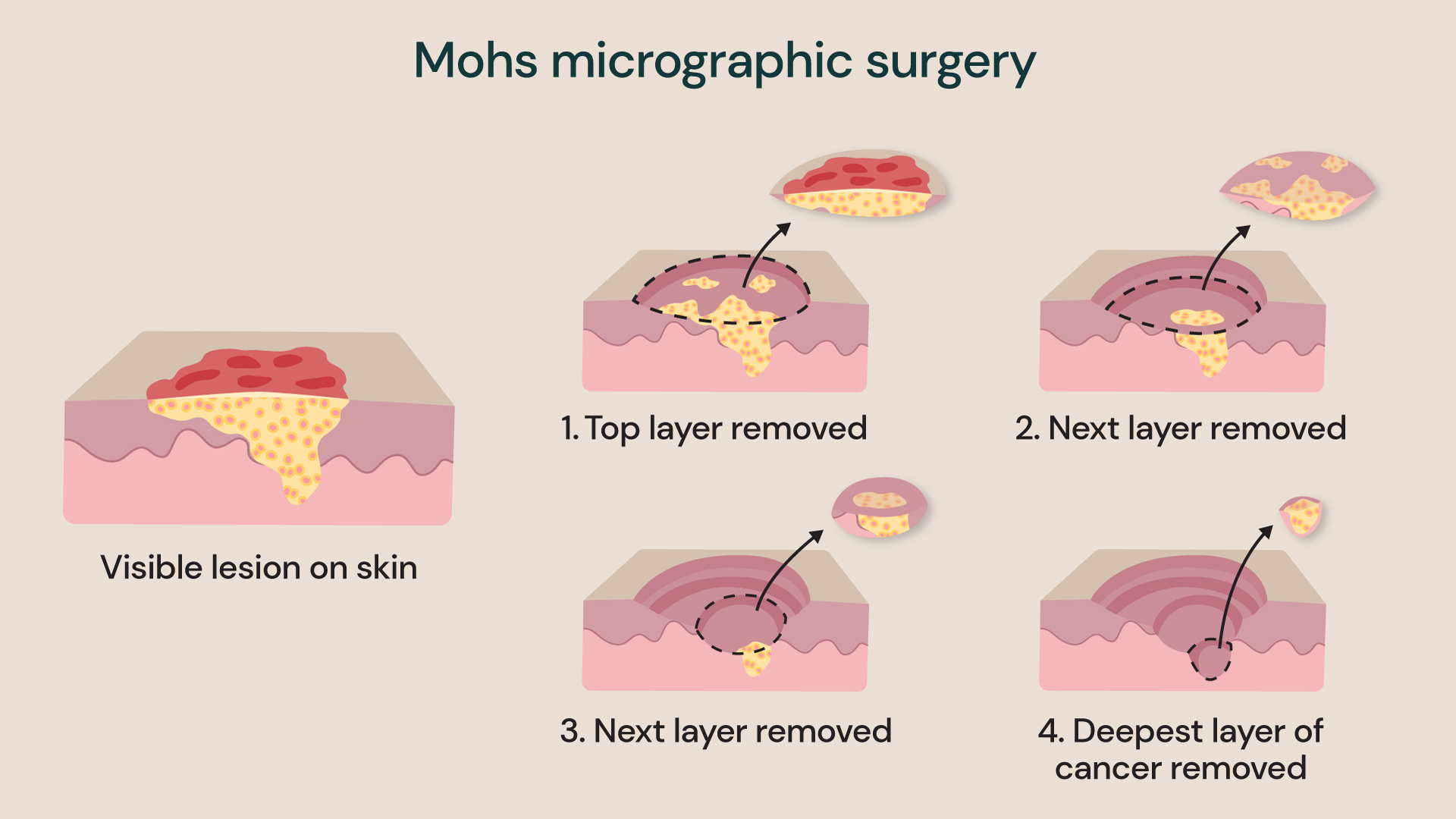Mohs micrographic surgery is an effective skin cancer treatment. At Guys and St Thomas’ Specialist Care, our dedicated dermatology team specialises in Mohs micrographic surgery to treat common skin cancers.
What is Mohs micrographic surgery?
Mohs micrographic surgery, is a specialised surgery that removes certain types of skin cancer. Experts consider Mohs micrographic surgery the most effective treatment for skin cancer, with up to a 99% cure rate.
Mohs micrographic surgery offers a way to treat skin cancer in a single appointment with the highest cure rate whilst also causing the least scarring to achieve this surgically. Our team is highly trained in performing Mohs micrographic surgery. They train other consultants in this technique both nationally and internationally, with Guy’s Hospital performing the most Mohs procedures of any centre in the country.
What does Mohs micrographic surgery treat?
Mohs surgery is most-commonly used to treat basal cell carcinomas (BCC) and squamous cell carcinomas (SCC). It is not used to treat melanoma.
Who is suitable for Mohs micrographic surgery?
Mohs micrographic surgery is most suitable for:
- BCC and SCC
- Lesions in cosmetically sensitive sites like the head and neck (in particular, the eyes, lips and nose)
- Patients with genetic conditions who have an increased risk of developing skin cancer
- recurrent or previously incompletely removed BCC or SCC
If you have skin cancer, our team will help you determine whether Mohs micrographic surgery is the correct treatment for your needs.
Preparing for Mohs micrographic surgery
Before having Mohs micrographic surgery, your surgeon will give you a thorough consultation to determine if this is the most suitable treatment.
They’ll explain any specific preparations you should make before attending your appointment.
How is Mohs micrographic surgery performed?
During Mohs surgery, the roots of the BCC or SCC are located and removed by extracting the tumour along with a thin layer of surrounding normal tissue. The tissue is then frozen and cut into thin slices which are dyed before being examined under a microscope in the clinic laboratory. If our team of specialists finds signs of cancer near the edge of the sample, they will remove a further slice of tissue in the area where the tumour remains. The process is repeated until they examine a sample with no evidence of cancer in it.
Prior to the procedure, the surgeon will draw around the visible carcinoma on the skin with a marker pen, before injecting a local anaesthetic. You will be fully awake for the duration of the procedure. The surgeon will then remove the tumour along with 1-2mm of healthy skin around and underneath it.
The surgeon creates a map of the surgical site and the parts of tissue which have been removed, allowing them to see exactly which parts of the removed tissue relate to which parts of the wound. If any further sections of tissue need to be removed, this method ensures the surgeon can operate with high precision and remove the minimum amount of tissue, improving healing and scarring.
After the tissue has been removed, your wound will be dressed and you will wait as the sample is examined in the laboratory. It can take 60-90 minutes for this part of the procedure to take place, and it will be repeated as many times as necessary throughout the day in order to remove the cancer layer by layer. The procedure will end when the surgeon reaches a layer with no cancer cells in it.
Although the tumour will be visible on the surface of your skin, the affected area can be much larger below the surface, so the size of the tumour isn’t always indicative of how many stages of removal you will experience on the day of surgery.

Mohs surgery is carried out by removing a layer of tissue at a time and examining it for evidence of cancer, before removing the next layer, until a layer with no cancerous cells is reached.
How long does Mohs micrographic surgery take?
The length of time that Mohs surgery takes varies depending on how many layers need to be removed to remove the skin cancer completely. Larger tumours also take longer to be examined, so tumour size also contributes to how long you can expect to be in the clinic on the day. We advise patients to prepare for an entire day in the clinic, although it may only take half a day.
Mohs micrographic surgery recovery
You can usually go home soon after we have completed the surgery. It’s normal to experience slight pain or discomfort afterwards, but over-the-counter pain relief medication like paracetamol or ibuprofen can help you manage it.
Your recovery and healing will depend on how the wound has been closed. In some cases, depending on the area of treatment, the wound can be left to heal naturally in a process called healing by secondary intention, which leaves a good cosmetic appearance. If this is what your surgeon recommends, you will be instructed how to look after the wound and how to apply further dressings.
Your surgeon may recommend a wound closure using stitches (primary closure), they may move tissue from looser skin in a nearby area (a flap), or they might use a piece of skin from another area to cover the wound (a skin graft). You will be given specific advice on how to care for the area, depending on how the surgeon chooses to close the wound.
In some cases, you may need a follow-up procedure with a plastic surgeon or an oculoplastic surgeon, and this is usually performed on the same day as your Mohs treatment, or in the days afterwards. Generally, patients can go home between the 2 procedures.
If you have non-dissolvable stitches, you’ll need to return 1 to 2 weeks later to remove them. We’ll also tell you if you need to attend a follow-up appointment for a check-up.
It can take up to 12 to 18 months for your scar to heal completely.
Benefits of Mohs micrographic surgery
Mohs micrographic surgery has the following benefits if you have skin cancer:
- a high cure rate
- typically causes a smaller scar than standard excision surgery
- an outpatient procedure so you can go home on the same day
- no general anaesthetic gives you a faster recovery time
Risks of Mohs micrographic surgery
All surgical procedures carry risks, but our team does everything they can to minimise them wherever possible.
The potential risks of Mohs micrographic surgery include:
- bruising and bleeding
- nerve damage (numbness in the area usually improves in the following weeks and months after surgery)
- permanent scar
- short term pain and swelling
- wound infection
Do not hesitate to contact us for advice if you are worried about your wound.
Locations
Our dermatology specialists offer Mohs micrographic surgery at the following locations:
Explore our team of dermatology specialists
Meet our team of dermatologists dedicated to providing world-class treatment in state-of-the-art facilities.
